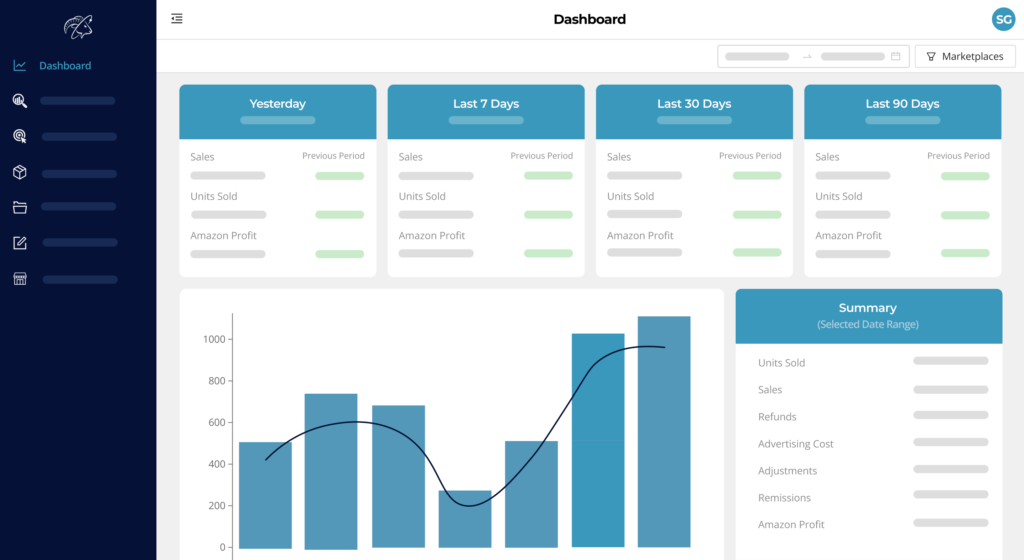Amazon Vendor vs. Seller vs. Broker
Wenn Du Dich auf Amazon als Verkäufer etablieren möchtest, stehst Du vor der Wahl, ob Du als Vendor, Seller oder Broker agierst. Jede dieser Optionen bringt eigene Vor- und Nachteile sowie spezifische Strategien mit sich, die Du berücksichtigen solltest. Als Amazon Vendor verkaufst Du Deine Produkte direkt an Amazon, das sie dann unter eigenem Namen weiterverkauft. Als Seller hingegen hast Du die volle Kontrolle über Deinen Verkaufsprozess und kannst direkt an die Kunden verkaufen. Ein Broker wiederum vermittelt zwischen Verkäufern und Amazon oder anderen Marktplätzen, ohne selbst Produkte zu besitzen. Diese verschiedenen Geschäftsmodelle haben Auswirkungen auf die Preisgestaltung, Marge, Markenkontrolle, Logistik und Kundenbeziehungen. Ein genauer Vergleich der Vor- und Nachteile kann Dir helfen, die beste Entscheidung für Deine geschäftlichen Ziele zu treffen.
Amazon Vendor vs Seller und warum diese Entscheidung vielleicht garnicht so wichtig ist
Vendor? Seller? Oder vielleicht sogar ein Hybrid-Modell? Viele E-Commerce-Unternehmen und Produkthersteller stellen sich die Frage nach dem für sie am besten passenden Vertriebsmodell auf Amazon. Wer längere Zeit als Vendor aktiv ist, sehnt sich vermutlich nach den Vorteilen, die Seller genießen und andersherum. Beim Vergleich von Amazon Vendor vs Seller zeigt sich, dass beide Modelle ihre spezifischen Vor- und Nachteile haben. Da die Entscheidungsmöglichkeiten ohnehin schon sehr begrenzt sind, werfen wir einfach mal ganz frech eine weitere Möglichkeit in den Raum.
Amazon Seller
Seller sind selbst für den Verkauf ihrer Waren zuständig. Sie nutzen Amazon als Marktplatz und sind zu jedem Zeitpunkt Produkt-Eigentümer. Nutzer des Seller Centrals profitieren von vollständiger Kontrolle über Verkaufspreise und Warenbestände. Sie treten direkt mit Endkunden in Kontakt (Direct to Consumer/D2C) und managen Versand sowie Retouren. Wahlweise können sie Fulfillment by Amazon (FBA) buchen. In diesem Fall wickelt Amazon unter anderem den Versand ab und bearbeitet Retouren.
Amazon Vendor
Verdoren verkaufen ihre Waren an Amazon und besetzen die Lieferantenrolle. Der E-Commerce-Riese ist Eigentümer der Produkte und kümmert sich um Logistik, Vertrieb und Versand. Auch die Preisgestaltung sowie das Retourenmanagement inklusive Kundenkontakt liegen beim Vendor- Programm im Verantwortungsbereich Amazons. Das Modell Amazon Vendor vs Seller zeigt hier, wie unterschiedlich die Zuständigkeiten verteilt sind
Ein Vergleich zwischen Amazon Seller und Vendor:
Daten
| Seller | Vendor |
|---|---|
| Business-Reports: Daten zur Auswertung von Salesdaten (Klicks, Impressions, Conversions etc.) | ARA-Berichte: ARA Basic und ARA Premium liefern Daten zur Handelsanalytik |
| Brand Analytics: Daten zur Analyse con Kauf- und Sucherverhalten | Brand Analytics: Daten zur Analyse con Kauf- und Sucherverhalten |
| API & Kundendaten: Hilfreiche API ermöglicht Analyse mit Drittanbietersoftware. Kundendaten. | API & Fehlende Daten: API kaum nutzbar. Salesdaten fehlen (Klicks, Impressions, Conversions etc.) |
Content
| Seller | Vendor |
|---|---|
| Upload & Änderungen | Upload & Änderungen |
| Content-Änderungen und -Uploads laufen über Self-Service (SC) oder LBD | Content-Änderungen und -Uploads laufen über verschiedene Support-Tickets |
| Richtlinien & Freigabe | Richtlinien & Freigabe |
| Änderungen durch automatisierte Prüfung meist schnell und unverändert sichtbar | Einhaltung von Richtlinien wird stärker kontrolliert und Freigaben dauern länger |
| Schreibrechte & Fehler | Schreibrechte & Fehler |
| Schreibrechte werden über Brand Registry beantragt. Änderungen nur selten. | Höchste Schreibrechte. Änderungen beim Content enthalten teilweise Fehler. |
Sonderprogramme, Ansprechpartner und Automatisierung
| Seller | Vendor |
|---|---|
| Sonderprogramme Sellern stehen aktuell keine vergleichbaren Programme zur Verfügung | Sonderprogramme Programme wie z.B. Amazon Fresh können genutzt werden |
| Ansprechpartner Advertising-Manager zur Erhöhung der Werbeausgaben. System-basiert, primär auf Self-Service. | Ansprechpartner Vendor-Manager, AVS und SVS werden weniger und sind meist bezahlt. Betreuen parallel diverse Marken – Entwicklung zum Self-Service. Advertising-Manager zur Erhöhung der Werbeausgaben. |
| Automatisierung API in vielen Bereichen hilfreich, Drittanbieter-Software kann unterstützen. | Automatisierung API in vielen Bereichen nicht ausgereift. Drittanbieter-Software problematisch. |
Logistik
| Seller | Vendor |
|---|---|
| Versandmodelle Seller können FBA und FBM nutzen. Prime-Badge bei beiden Modellen möglich. | Versandmodelle Vendoren können FBA und Dropshipping nutzen. Prime-Badge, Prime Now und Same Day Delivery möglich. |
| Versandvorgaben Strenge Vorgaben bei Verkäuferleistung. Risiko auf Kontosperrung sichert Einhaltung der Ziele. Menge und Lieferzeitpunkt frei wählbar. | Versandvorgaben Strenge Vorgaben durch Vendor-Manual. Strafzahlungen sichern Einhaltung der Ziele. Amazon bestimmt Menge und Lieferzeitpunkt. |
| Versandabwicklung Amazon übernimmt Rücksendungen, Versandbestätigungen etc. bei FBA. Bei FBM muss sich der Verkäufer selbst um diese Aufgaben kümmern. | Versandabwicklung Amazon übernimmt Rücksendungen, Versandbestätigung etc. bei FBA. |
Produktlistung und Lagerbestand
| Seller | Vendor |
|---|---|
| Produktlistung Sofort-Listung möglich. | Produktlistung Listung nur bei Sell-In möglich. |
| Lagerbestand Eigenständiges Management von Lagerbestand (Forecast Lagerreichweite). Zeitpunkt und Menge der Einlagerung kann frei festgelegt werden. | Lagerbestand Amazon bestellt kaum mehr Vollsortiment. Fokus auf Profitabilität einzelner Artikel. Nachbestellung 100 % automatisiert basierend auf Kaufwahrscheinlichkeit. |
| Auslistung Ausgelistet werden nur Artikel, die gegen die Richtlinien von Amazon verstoßen. | Auslistung Erfüllt ein Artikel nicht mehr die Profitabilitätsvorgaben, wird nicht mehr nachbestellt – es kommt zum CRaP-Out (Can’t Realize any Profit). |
Buchhaltung
| Seller | Vendor |
|---|---|
| Rechnungen Rechnungen für z.B. Verkaufsgebühren von Amazon können über einfache Reports generiert werden. Seller verkaufen direkt an Endkunden und müssen daher zusätzlich Rechnungen erstellen und über das System von Amazon versenden. | Rechnungen Komplexe Verrechnungen sorgen für Aufwand. Beispielsweise werden Rabatte und Strafzahlungen mit Warenkäufen verrechnet. Rechnungen kommen aus verschiedenen Ländern und enthalten nur teilweise Umsatzsteuer. |
| Internationalisierung Beim Verkauf im Ausland müssen Umsatzsteuer-Themen wie Lieferschwellen eigenständig überwacht werden. Spezialisierte Drittanbieter-Software kann dabei unterstützen. | Internationalisierung Amazon verkauft die Waren als Händler und übernimmt daher die internationale Rechnungsstellung. |
Kosten
| Seller | Vendor |
|---|---|
| Keine Verhandlungen, fixe Kontogebühren, Verkaufsgebühren (7-15 %) und optionale Kosten durch FBA. | Individuelle Verträge mit diversen Sondervereinbarungen wie Rückgabevereinbarungen und Listungsgebühren. |
Konkurrenz mit Handelspartnern
| Seller | Vendor |
|---|---|
| Für Endkunden ist der Verkäufername und das Impressum einsehbar – somit könnte eine offensichtliche Konkurrenzsituation mit Handelspartnern entstehen. | Für Endkunden ist der Lieferant nicht einsehbar. Auf der Produktseite erscheint nur die Info “Verkauf durch Amazon” – somit entsteht keine offensichtliche Konkurrenzsituation mit Handelspartnern. |
Preis
| Seller | Vendor |
|---|---|
| Seller legen den Preis eigenständig fest. Zu hohe Preise können zu schlechteren Performance-Werten und somit indirekt zu schlechteren Rankings führen. Zu hohe Preise können zu einem Verlust der Buybox führen. | Preisfindung 100 % automatisch durch Abgleich mit internen und externen Wettbewerbern. Ausnahmen: Promotion-Preise, Überbestände und Langzeitlagerbestand. Bei unkontrollierter Preispolitik können automatisierte Preissenkungen zu Profitabilitätsdruck führen und Handelspartner, die sich an Preisempfehlungen halten, verärgern. Bei gleichem Preis gewinnt der Vendor meist die Buybox. |
Personal-/Ressourcenaufwand
| Aufgabenbereich | Seller | Vendor |
|---|---|---|
| Inventur-Management | 👤👤👤 | 👤 |
| Prime Logistik | 👤 | 👤 |
| Internationalisierung | 👤👤👤 | 👤 |
| Preiskontrolle | 👤👤 | 👤 |
| Buybox-Kontrolle | 👤👤 | 👤 |
| SEO Steuerung | 👤👤👤 | 👤👤👤 |
| Branded Content (inkl. Videos) | 👤👤👤 | 👤👤👤 |
| Produkt-Tests | 👤 | 👤 |
| Kommunikation mit Kunden | 👤 | 👤 |
| Daten und BI | 👤👤 | 👤👤 |
| Launch neuer Produkte | 👤👤 | 👤 |
| Sponsored Ads (inkl. SD Re-Targeting) | 👤👤 | 👤👤 |
| Amazon DSP | 👤👤👤 | 👤👤👤 |
| Angebote/ Promotions | 👤👤 | 👤 |
| Potentielle Konflikte mit Handelpartner | 👤👤 | 👤 |
| Konditionsgespräche mit Amazon | 👤 | 👤👤👤 |
| Total | 👤👤👤 | 👤👤 |
Amazon Vendor vs. Seller: Das Hybridmodell
Bei dem hybriden Vertriebsmodell agiert der Hersteller gleichzeitig als Vendor und Seller. Dieses Modell kombiniert beide Vertriebsformen. Diese Art der Geschäftsbeziehung beinhaltet sowohl Vorteile als auch Risiken. Durch die Kombination der Modelle Amazon Vendor vs Seller im Hybridmodell können Unternehmen von beiden Welten profitieren.
Vorteile des Hybridmodells
Grundsätzlich verspricht das Hybridmodell mehr Flexibilität und höhere Sicherheit. Mithilfe einer durchdachten Marktplatzstrategie können Sie sich die Vorteile des Modells zu Nutzen machen:
- Verfügbarkeit der Produkte sicherstellen
- mehr Kontrolle über Preisgestaltung als im Vendormodel
- Produkte schneller listen
- spezifische Analysedaten über Seller Central
- logistische Vorteile
- Profitabilitätsprobleme bei ausgewählten Produkten umgehen

Herausforderungen des Hybridmodells
Eine kombinierte Verkaufsstrategie sollte gut durchdacht sein, denn das Hybridmodell birgt auch einige Fallstricke. Unter Umständen toleriert Amazon den Seller Account nicht oder sperrt einzelne Produkte für den Vertrieb über diesen. Das Hybridmodell stellt Markenhersteller vor eine Reihe von Herausforderungen:
- erhöhter Arbeitsaufwand
- Kundenzufriedenheit & Endkundensupport
- länderspezifische Gesetze müssen noch mehr eigenständig beachtet werden
- Wettbewerb mit eigenen Großhandelskunden
- Möglichkeit eines gesperrter Seller Account und damit einhergehende Umstände

Die Alternative: SPACEGOATS - Amazon Broker
SPACEGOATS bietet eine eigene Software, die du als Onlineseller statt Seller Central nutzt – “Selling as a Service”. Mit dieser kannst du Listings, Produkte, Lageranlieferung, PPC und Co. managen. Eine optimierte Version des Seller bzw. Vendor Central mit zusätzlichen Servicen und Features. Diese beinhalten eine automatisierte Lieferkette und PPC sowie die Anbindung an alle europäische Amazon Markplätze. Du interagierst nicht direkt mit deinem Amazon-Konto, sondern über die Software indirekt mit dem Amazon-Konto von SPACEGOATS, deinem “Amazon Broker”. Dadurch entfällt die eigene umsatzsteuerliche Registrierung im Ausland. Was zunächst kompliziert klingt, wird gleich deutlicher.
Deine Vorteile mit SPACEGOATS:
- Verfügbarkeit der Produkte sicherstellen
- Produkte schneller listen
- spezifische Analysedaten
- logistische Vorteile
- Schutz vor Accountsperrung
- Geringerer Arbeitsaufwand
- Kundenzufriedenheit
- Abwicklung der Compliance Aufgaben
#1: Verfügbarkeit der Produkte sicherstellen
Während das Hybridmodell hier auch schon einige Vorteile gegenüber dem klassischen Vendor-Modell zeigt, bietet SPACEGOATS eine vollautomatisierte Just-in-Time-Anlieferung aus Pre-FBA-Lagern. Fulfillment-Partner füllen somit automatisch das Amazonlager auf, damit deine Produkte nie Out of Stock sind. Cooler Nebeneffekt ist die Optimierung deines LBI. Du genießt damit die flexible Absprache und Anlieferung mit Dritten-Fulfillment-Partnern und versendest trotzdem über Prime an deine Kunden.
#2: Produkte schneller listen
Vendoren müssen meist mehrere Wochen darauf warten, dass Amazon einen Artikel hochlädt. Seller können ihre Produkte in kürzerer Zeit auf Amazon verfügbar machen. Wer über SPACEGOATS verkauft kann nicht nur schnell neue Produkte listen, sondern auch schnell auf neue Marktplätze expandieren, ohne jeglichen administrativen Aufwand. Viele einzelne Marktplätze werden dadurch zu einem großen Marktplatz. Als Amazon Broker bietet SPACEGOATS zudem Unterstützung bei der Expansion auf internationale Märkte, was sonst oft sehr aufwendig ist.
#3: Spezifische Analysedaten
Seller stehen deutlich mehr aussagekräftige Informationen zu wichtigen Kennzahlen zur Verfügung, wie bspw. die Conversion Rate. Vendoren müssen hierauf leider fast komplett verzichten. SPACEGOATS geht hier allerdings noch einen Schritt weiter und stellt nicht nur detaillierte Informationen zu den eigenen Produkten, Verkaufs- und Umsatzzahlen bereit, sondern bietet auch eine laufende Konkurrenzanalyse, die beim Wettkampf um die Spitzenpositionen unterstützt. Darüberhinaus ist SPACEGOATS Teil des Amazon 360 Programms, wo Amazon weitere Informationen mit Sellern teilt und einen viel weiterreichenden Support bietet. Von den Informationen und Daten die Amazon hierüber bereitstellt, profitieren logischerweise auch SPACEGOATS Kunden, da der Erfolg von SPACEGOATS vom Erfolg ihrer Kunden abhängt.
#4: Logistische Vorteile
Ob Anlieferbeschränkungen, die Angst das Produkte Out of Stock gehen könnten oder lässtige Anlieferpläne schreiben zu müssen, mit SPACEGOATS kommunizierst du mit geprüften Pre-FBA- und Fullfilmentpartnern, die vollautomatisiert die Verfügbarkeit deiner Produkte im Amazonlager sicherstellen. Hier zeigt sich, dass ein Amazon Broker wie SPACEGOATS die logistischen Herausforderungen deutlich reduziert.
#5: Schutz vor Accountsperrung
Multichannel Seller werden bei einer Accountsperrung “nur” Umsatzeinbussen verzeichnen. Wohingegen reine Amazon Seller ihre Umsatzgrundlage verlieren. Seller sind dieser Gefahr natürlich mehr ausgesetzt als Vendoren. Beim Verkauf über SPACEGOATS benötigen Seller keinen eigenen Amazon-Account, der somit auch nicht gesperrt werden kann.
#6: Geringerer Arbeitsaufwand
Das Hybridmodell beinhaltet das Management sowohl von Seller als auch von Vendor Central und setzt ein Grundverständnis beider Systeme voraus. Neben deinem Vendor Account bist du als Seller zusätzlich für verschiedene Aufgaben verantwortlich, darunter die Lagerung inklusive Arbeitskosten, die Steuerung des Inventars, die Bearbeitung von Kundenbestellungen, den Customer Support und das Steuerwesen. Um diese Herausforderungen zu meistern, bietet SPACEGOATS die Möglichkeit, viele dieser Prozesse zu automatisieren. Dazu gehören unter anderem die Automatisierung von PPC-Kampagnen über BidX, das automatische Versenden von Review-Anfragen, die automatisierte Anlieferung, automatische Preisanpassungen sowie die automatische Rechnungsstellung und viele weitere Funktionen, die deinen Arbeitsalltag erleichtern.
#7: Kundenzufriedenheit
Amazon legt den Fokus auf Kundenzufriedenheit. Hiervon profitieren Vendoren, da der Handelsriese Versand, Customer Support und Retourenabwicklung besonders kundenorientiert gestaltet. Beim Seller-Modell fallen diese Aufgaben in den eigenen Verantwortungsbereich. Seller sind dazu gezwungen, Amazons hohe Ansprüche im Hinblick auf Kundenfreundlichkeit ebenfalls zu erfüllen. Falls Retourenabwicklung oder Kundenbetreuung nicht zufriedenstellend funktionieren, wird der Seller von Amazon-Kunden schlecht bewertet. Dies hat wiederum negative Auswirkungen auf die gesamte Seller Performance. Im schlimmsten Fall sperrt Amazon den Seller Account. Verkaufst du über SPACEGOATS liegt die Kundenbetreuung für alle Marktplätze bei SPACEGOATS und du benötigst dir hierüber keine Gedanken mehr zu machen. So können wir dich als Amazon Broker effizient unterstützen.
Abwicklung der Compliance Aufgaben
Im Fall des Vendor-Programms ist Amazon als Seller für die rechtlichen Belange verantwortlich, die sich aus dem internationalen Verkauf ergeben. Bei einem Seller Account musst du dich allerdings mit den länderspezifischen Gesetzen vertraut machen, wie u.a. der Umsatzsteuer-Richtlinie. Als Seller bist du an alle rechtlichen Vorgaben des jeweiligen Landes gebunden, in dem du verkaufst. Bei SPACEGOATS arbeitest du mit dem Customer Success Team zusammen, die die Compliance-Vorschriften kennen und dich nur dann einbeziehen, wenn sie Informationen von dir benötigen. Alle Compliance-Themen die ohne Informationen von dir geklärt werden können, übernimmt SPACEGOATS automatisch selbst.

Finde das richtige Modell für dein Unternehmen
Fakt ist, es gibt kein richtig oder falsch und es gibt keine perfekte Lösung. Alle Vertriebsmodelle bieten ihre Vor- und Nachteile. Entscheidend ist, dass es zur Situation, deinem Unternehmen und deiner Gesamtstrategie passen muss. Wir empfehlen dir eine ausführliche Potential- und Risikoanalyse von den Modellen zu machen, die für dich infrage kommen.
Übrigens:
Sollte dein Account oder einzelne Listings bereits gesperrt sein, kannst du mit SPACEGOATS in kürzester Zeit wieder aktiv verkaufen. Möchtest du deine Einnahmequelle schützen und die Risiken, die eine potenzielle Account- oder Listingsperrung mit sich bringt reduzieren, kannst du SPACEGOATS als eine Art inaktive Backup-Lösung nutzen. Du nutzt SPACEGOATS nur dann aktiv, wenn du nicht mehr verkaufen kannst.
Ich hoffe, dass ich dir mit dieser Übersicht zumindest ein wenig weiter helfen und dir einen guten Einblick in die Möglichkeiten auf Amazon zu verkaufen geben konnte. Solltest du Fragen haben oder weiter Informationen benötigen, buch dir gerne einen kostenlosen und unverbindlichen Termin unter https://spacegoats.io/schedule-a-call.
Galaktische Grüße
Anton

